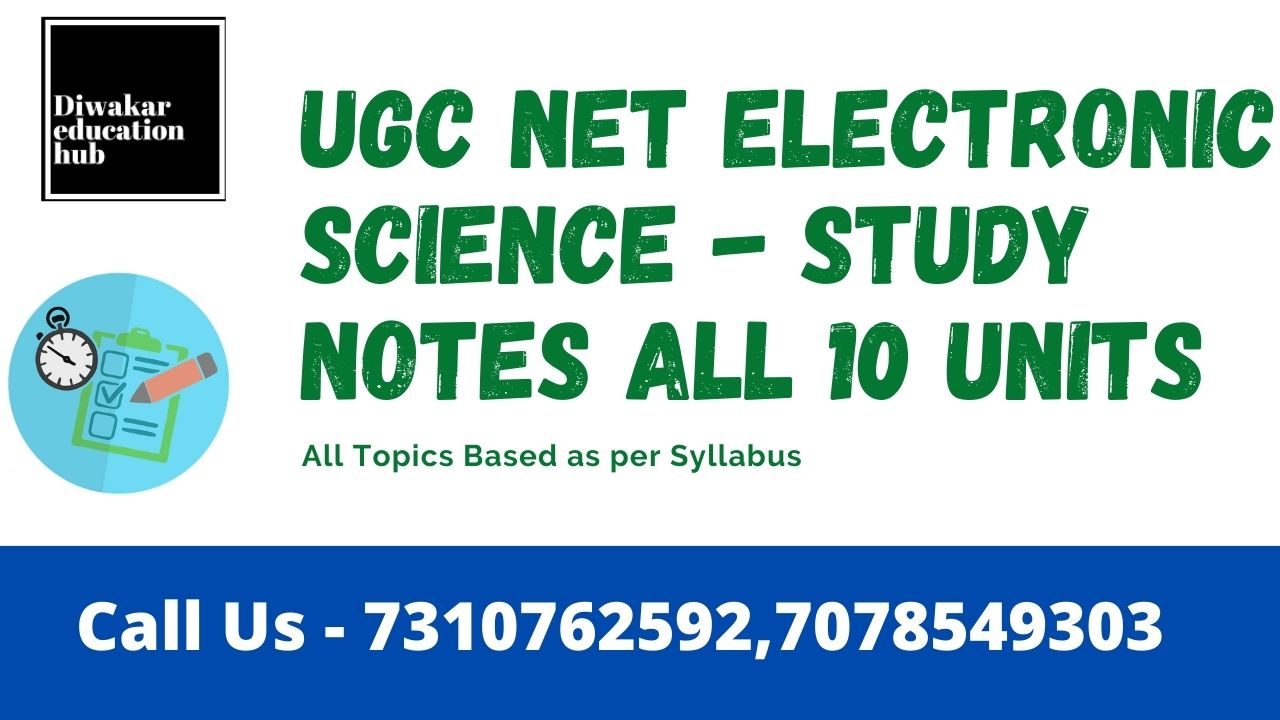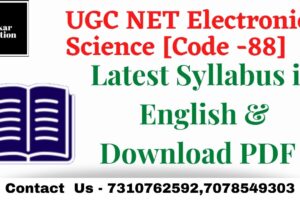UGC NET Electronic Science Latest Study Notes of All [10 Units] Syllabus 2024

UGC NET Electronic Science Study Notes: The syllabus is Vast & stiff. After analyzing the Syllabus Thoroughly. The next step is Selecting the Best study notes to start preparation. Choosing the best study notes is a Very Essential & Important step for Exam Preparation, Because notes Not Only even guide you but also summarize your study Plan, If You selected the Right Notes it’s Mean you Have completed 50% of the Work, after selecting the right notes you just need to read thoroughly & Revise According to Your Time Table or Strategy Plan, In Case if you Having, Another wise You Can Fellow strategy given end of the article
How to Select Best Study Notes What should be Looked into it?
Three Simple Steps
- Its Should be in Details Cover Each & Every Subject Topics As Per Given in syllabus
- Should be Unit wise Question Answer So that you can Practice MCQ of Each Unit topics
- Should be As Per the Updated Syllabus Take a Preview of Complete Notes Before Buying If Possible
- UNIT-I Introduction to Semiconductor
- UNIT-II IC fabrication
- UNIT-III Superposition
- UNIT–IV Rectifiers
- UNIT-V Logic Families
- UNIT -VI Introduction of Microprocessor
- UNIT-VII Electrostatics
- UNIT- VIII Analog modulation and demodulation
- UNIT-IX Power devices
- UNIT -X Transducers
| Unit/Subject Name | Link to Read |
|---|---|
| Unit -1 Electronic Science | https://wa.link/v4xfaz |
| Unit -2 Electronic Science | https://wa.link/v4xfaz |
| Unit -3 Electronic Science | https://wa.link/v4xfaz |
| Unit -4 Electronic Science | https://wa.link/v4xfaz |
| Unit -5 Electronic Science | https://wa.link/v4xfaz |
| Unit -6 Electronic Science | https://wa.link/v4xfaz |
| Unit -7 Electronic Science | https://wa.link/v4xfaz |
| Unit -8 Electronic Science | https://wa.link/v4xfaz |
| Unit -9 Electronic Science | https://wa.link/v4xfaz |
| Unit -10 Electronic Science | https://wa.link/v4xfaz |
| Total Unit | 10 |
Latest Syllabus UGC NET Electronic Science 2024
| Units | Subject /Topics /Content |
| UNIT-I | Introduction to Semiconductor, energy bands in solids, concept of effective mass, density of states, Fermi levels. PN Junction, Diode equation and diode equivalent circuit, Breakdown in diodes, Zener diode, Tunnel diode, Metal semiconductor junction – Ohmic and Schottky contacts, Characteristics and equivalent circuits of JFET, MOSFET. Low dimensional semiconductor devices – quantum wells, quantum wires, quantum dots. High Electron Mobility Transistor (HEMT), Solar cells – I-V characteristics, fill factor and efficiency, LED, LCD and flexible display devices. Emerging materials for future Devices: Graphene, Carbon Nano tubes (CNT), ZnO, SiC etc. |
| UNIT-II | IC fabrication – crystal growth, epitaxy, oxidation, lithography, doping, etching, isolation methods, metallization, bonding, Thin film deposition and characterization Techniques: XRD, TEM, SEM, EDX, Thin film active and passive devices, MOS technology and VLSI, scaling of MOS devices, NMOS and CMOS structures and fabrication, Characteristics of MOS transistors and threshold voltage, NMOS and CMOS inverters, Charge-Coupled Device (CCD) – structure, charge storage and transfer, Basics of VLSI design, stick diagrams, Layout design rules. |
| UNIT-III | Superposition, Thevenin, Norton and Maximum Power Transfer Theorems, Network elements, Network graphs, Nodal and Mesh analysis. Laplace Transform, Fourier Transform and Z-transform. Time and frequency domain response, Passive filters, Two-port Network Parameters : Z, Y, ABCD and h parameters, Transfer functions, Signal representation, State variable method of circuit analysis, AC circuit analysis, Transient analysis, Zero and Poles, Bode Plots. 2 Continuous time signals, Fourier Series and Fourier transform representations, Sampling theorem and applications, Discrete time signal, Discrete Fourier transform (DFT), Fast Fourier transform (FFT), Basic concepts of digital signal processing, digital filters – IIR, FIR. |
| UNIT-IV | Rectifiers, Voltage regulated ICs and regulated power supply, Biasing of Bipolar junction transistors and FETs, operating point and stability, Amplifiers, Classification of amplifiers, Concept of feedback, Hartley, Colpitt’s and Phase Shift oscillators, Operational amplifiers (OPAMP) – characteristics, computational applications, comparators, Schmitt trigger, Instrumentation amplifiers, wave shaping circuits, Phase locked loops, Active filters, Multivibrators, Voltage to frequency convertors (V/F), frequency to voltage convertors (F/V). |
| UNIT-V | Logic Families, Logic Gates, Boolean algebra and minimization techniques, Combinational circuits, Programmable Logic Devices (PLD), CPLD, flip-flops, memories, Sequential Circuits: Counters – Ring, Ripple, Synchronous, Asynchronous, Shift registers, multiplexers and demultiplexers, A/D and D/A converters, Analysis and Design of fundamental mode state machines: State variables, State table and State diagram. Sequential PLD, FPGA, Analysis and Design of digital circuits using HDL. |
| UNIT-VI | Introduction of Microprocessor 8086: Architecture, Addressing modes, instruction set, interrupts, Programming, Memory and I/O interfacing. Introduction of Microcontrollers – 8051 for embedded systems, Architecture and register set of Microcontroller 8051, Addressing modes, Instruction set of 8051 – Data transfer instructions, Arithmetic instructions, Logic instructions, bit level and byte level control transfer instructions, 8051 assembly programming – stack operations, subroutines, interrupts, 8051 programming as timer/counter, 8051 serial communication, 8051 interfacing RS232, LED/LCD display, Keyboard , Stepper motor. |
| UNIT-VII | Electrostatics – vector calculus, Gauss’s Law, Laplace and Poisson’s equations, Magnetostatics – Biot Savert’s law, Ampere’s law and electromagnetic induction, Maxwell’s equations and wave equations, Plane wave propagation in free space, dielectrics and conductors, Poynting theorem, Reflection and refraction, polarization, interference, coherence and diffraction, Transmission lines and waveguides – line equations, impedance, reflections and voltage standing wave ratio, rectangular waveguides. Antennas – retarded potential and Hertzian dipole, half wave antenna, antenna patterns, radiation intensity, gain, effective area and Frii’s free space receiver power equation. 3 Microwave Sources and Devices -Reflex Klystron, Magnetron, TWT, Gunn diode, IMPATT diode, Crystal Detector and PIN diode. Radar – block diagram of Radar, frequencies and power used, Radar range equation |
| UNIT-VIII | Analog modulation and demodulation – AM, FM and PM, Principle of super heterodyne receiver, Random signals, noise, noise temperature and noise figure, Basic concepts of information theory, Error detection and correction, Digital modulation and demodulation – PCM, ASK, FSK, PSK, BPSK, QPSK and QAM, Time and Frequency-Division Multiplexing, Multiple Access techniques, Data Communications – Modems, Codes, Principles of Mobile and Satellite Communication, Optical communication, Optical sources – LED, spontaneous and stimulated emission, semiconductor Lasers, Detectors – PIN photodiodes, Avalanche photodiodes (APD), Optical fibers – attenuation and dispersion characteristics, Bandwidth, Wavelength division multiplexing. Fundamentals of Internet of Things (IoT) for communication. |
| UNIT-IX | Power devices – characteristics of SCR, DIAC, TRIAC, power transistors, Protection of thyristors against over voltage and over current. SCR triggering – dv/dt and di/dt, triggering with single pulse and train of pulses, A.C. and D.C. motors – construction and speed control. Switched Mode Power Supply (SMPS). Uninterrupted Power Supply (UPS). Open loop and closed loop control system, Block Diagram reduction techniques, transfer function and signal flow diagram, Stability criterion: Routh-Hurwitz and Nyquist plot, On-off controller, Proportional (P), Proportional-Integral (PI), Proportional-Derivative (PD), PID controllers. |
| UNIT-X | Transducers – Resistance, Inductance, Capacitance, Piezoelectric, Thermoelectric, Hall effect, Photoelectric, Measurement of displacement, velocity, acceleration, force, torque, strain, temperature, pressure, flow, humidity, thickness, pH. Measuring Equipment – Measurement of R, L and C, Bridge and Potentiometers, voltage, current, power, energy, frequency/time, phase, Digital Multimeters, CRO, Digital Storage Oscilloscope, Spectrum Analyzer., Biomedical Instruments – ECG, EEG, Blood Pressure Measurements, MEMS and its applications Sensors for IoT applications. |
Career Scope After Qualfied UGC NET Electronics Science
Qualifying UGC NET with Electronics Science opens up a bunch of exciting career paths for you. Here are the major ones to consider:
- Teaching and Research: This is the most common route. UGC NET qualifies you for Assistant Professor positions in universities and colleges across India. You can pursue research alongside teaching, and the fellowship earned through UGC NET can help fund your PhD studies.
- Research Fellowship: The Junior Research Fellowship (JRF) is another benefit of qualifying UGC NET. This fellowship provides financial assistance for pursuing research in your chosen field within Electronics Science.
- Beyond Academia: Your expertise in Electronics Science is valuable beyond colleges and universities. You can look for opportunities in research labs, government organizations like DRDO or ISRO, or even in Public Sector Undertakings (PSUs) dealing with electronics and technology.
- Content Creation and Training: If you enjoy sharing your knowledge, you can become a freelance writer or editor for educational publications or online platforms. You can also train aspiring UGC NET Electronics Science candidates by opening a coaching institute or creating online courses.
Remember, these are just some of the possibilities. The specific career path you choose will depend on your interests, skills, and long-term goals.
Some of them are
- Work in Govt and Private Colleges and Universities
- ·Work as Analyst, Manager and Senior Consultants in Various Companies
- Become an Author and Editor of Books
- Electronics Service Maintenance Engineer
- Production Specialist
- Analyst
- Doctorate Degree in Electronic Sciences
- Job in PSUs such as IOCL, BHEL, HPCL, NTPC, etc.
- Writer or Editor of Electronics Science’s Books
- Trainer to Electronic Science Students Etc
Frequently Asked Questions Electronic Science –
What are the study materials offered by Diwakar Education Hub for the UGC NET Electronic Science Exam?
Ans- The Diwakar Education Hub offers a complete package of study materials to prepare for the UGC NET Electronic Science Exam which has 10 Unit Wise Booklets With Theory + Unit Wise 4000+ Question Answer As per Exam Pattern Which are the Details Notes Cover Each & Every Topic of Syllabus.
Why are the notes important for UGC NET Electronic Science Exam?
Ans- Yes, the UGC NET History Notes are very vital for the students to revise the complete portions that they studied for the UGC NET Electronic Science Exam.
How can the students prepare the UGC NET History Electronic Science?
Ans- Students can prepare the UGC NET Electronic Science Study material from the UGC NET Electronic Science Study Materials. They can go for our Notes Thoroughly for the preparation of the UGC NET Electronic Science Notes.
What kind of books can be used to prepare the UGC NET History Notes?
Ans- There are Many Books Available in the Market but a Single book does not cover all which you need to cover for an Exam perspective. But a Detailed Study Material Like Have you will get all that you need to crack this Exam.
What are some tips to take notes for the UGC NET Electronic Science Exam?
Ans-Candidates can go for online searches to get notes for complicated subjects. Candidates can make charts like for remembering the years of the wars. Candidates can make use of several books for a single topic that will improve their understanding. Through all these steps candidates can make their own UGC NET Electronic Science Notes or Can Choose Our Notes.
Tag:complete reference on electronic science ugc, handwritten notes for ugc net electronic science, made easy ugc net electronic science, trueman's ugc csir-net electronic science pdf, UGC NET Electronic Science book PDF, ugc net electronic science books arihant, ugc net electronic science handwritten notes pdf free download, ugc net electronic science notes pdf free download, ugc net electronic science study material free download pdf, ugc net electronic science study material pdf, ugc net electronic science topic wise questions



